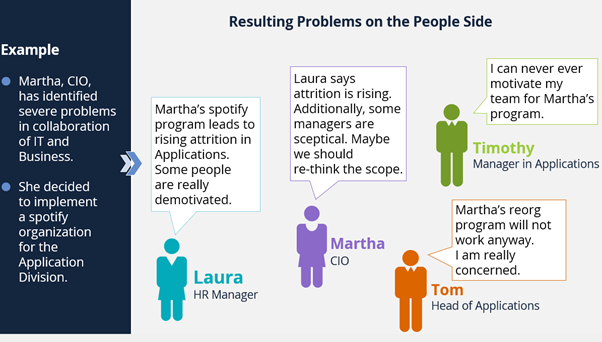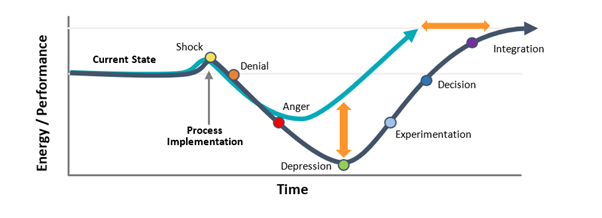The largest part of an iceberg – and the most dangerous one for captains and leaders – is below the water. Thus, the iceberg model is helpful in demonstrating what happens in many large-scale transformation programs. The technical and operational part, which is visible and tangible above the surface, receives the full attention of leaders, while the people side below the surface is often neglected. This tendency to look at only the visible parts above the water causes more than 70% of program failures. It results in either a lack of support for change from management or employee resistance.
Organizational change management (OCM) can make a difference.

Figure 1: The people side of transformation is often neglected though it is crucial to success
Managing the People Side of Transformation Programs
To a neuroscientist, this may not be surprising. The human brain does not like change. From a neuroscientific perspective, the brain’s job is to secure the current state. This means, as long as the current state is reasonably OK, the brain will argue for preserving it. Thus, people stay in a flat they rented years ago as a “temporary solution,” or they stay in a job they find boring because they hesitate to take the risk to move to a new one. Psychologists call this resignative contentment.
Maintaining the status quo is what the brain does with good intentions. It wants to preserve the person in the known safety of the current state.
Expand the Safety Zone
Expanding people´s individual safety zones can be done with two building blocks of OCM:
- Trusting relationships – People are more likely to demonstrate willingness to change when they feel psychologically safe. And feeling safe within the organizational environment heavily depends on the relationships one has based on a certain level of trust. Strong, trusting relationships facilitate transformations with high change impact on people, either through existing associations or by creating new ones.
- Leader competencies – Relationships, especially with team leaders, are crucial for successful transformations. Team leads gain and provide the highest level of trust from their own teams within organizations. Therefore, measures to win early buy-in and strengthen leadership competencies are integral parts of OCM. Often, management misses out by not involving them in the early stages of a transformation and equipping them with too little information. This results in team leads distrusting the top program management. That is why intense and early involvement of important change leadership roles is a key building block in OCM.
Motivate Employees with What Matters to Them
An employee would rarely be motivated to undergo a transformation driven solely by key performance indicators (KPIs), a fast return on investment (ROI), a higher earnings number or further company growth. These strategic goals are mainly of interest to managers with bonuses tied to these objectives or to shareholders. Instead, the employee is interested in: What´s in it for me? What does it mean for me personally? What are my benefits? What happens to my salary, to my intracompany pension entitlement and whether I’m still sitting next to my favorite colleagues? These and similar questions must be answered. Detailed information on the employees´ new job tasks, new colleagues, new managers, offers on upskilling, new badges, contractual agreements, etc. must be part of the change program communication.

Figure 2: Problems on the People Side: An Example
Motivation also can be strengthened by inviting employees to be proactive participants in the transformation. Corresponding measures can be bundled under one headline: management of participation. Information, exchange and dialogue on these topics can be addressed in forums like marketplaces, question-and-answer sessions in town halls, learning coffee sessions or in team meetings. It’s about creating room for discussions on the why, how, what and what’s in it for me of the transformation program.
Build New Motorways
The human brain likes habits and routines. For those, it has established broad motorways, which are well known and easy to use. Developing new habits requires building a new “motorway” that requires repetition and effort: bundles of communication, frequent town halls, mindful stakeholder relationship management, team meetings, etc. A single town hall will not be enough to win people over. It requires a well-combined mix of trust-building change management activities.
The Change Curve and Neuroscience
The change curve displays typical reactions of people affected by change. Elisabeth Kübler-Ross created the curve in 1969 to apply to individuals in severe change situations like grief and death. Today, it is also applied to people’s reactions during large-scale transformations within organizations. Although the curve is much older than the neuroscientific insights quoted above, it fits neuroscientific findings concerning the natural resistance to change quite well.

Figure 3: The Change Curve
When the transformation is profound and people are impacted severely, they will experience all stages on the change curve. By implementing OCM measures, you cannot prevent all discomfort that comes with change, but you can mitigate the negative effects. The curve runs flatter and shorter.
Structured Framework
OCM helps win over people for change because it offers support in creating an environment of trust and provides individual motivation. This requires a bundle of assessments, analysis and workshops to identify suitable measures that can be launched according to the agreed OCM roadmap. Of course, it has to be undertaken in an effective and structured way. For this, ISG has developed a structured framework to support large-scale transformations with OCM.
If you would like to learn more about ISG’s OCM framework, we are happy to schedule an expert call.
